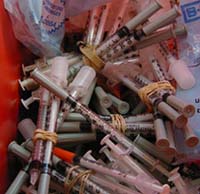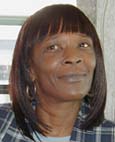| Baltimore Struggles to Slow
Spread of Drug-fueled HIV

|
Thousands of used needles are deposited every day through Baltimore's needle exchange program. (Newsline
Photo by Fanen Chiahemen)
|
By Fanen Chiahemen and Amanda Karr
Maryland Newsline
Friday, May 9, 2003
BALTIMORE -
It's 9:30 on a Tuesday morning and Jeff Long, a health counselor for
Baltimore City’s needle exchange program, is at work in an RV parallel-parked
along North Caroline Street.
“Hold up the needles so I can see them. Don’t put anything on the table,” he
tells the habitual intravenous drug users who one-by-one climb into the RV.
One man, who is well-groomed but casually dressed, pulls eight needles out of
the front pocket of his sagging blue jeans. Another removes a single needle
from a brown paper lunch bag he’s carrying. Both drop the needles into a blue
plastic bucket beside them.
Long hands each person who turns in dirty needles five fresh ones.
Baltimore’s needle exchange program is just one of a growing number of ways
HIV is being combated in a city that accounts for slightly more than half of
all of Maryland’s cases of AIDS and HIV-- and where drug use feeds the epidemic.
According to Maryland AIDS Administration statistics released last
year, 12,292 people in Baltimore were living with HIV or AIDS, out of 24,480
in Maryland. Of those in Baltimore, roughly 55 percent were
infected through intravenous drug use.
Statewide in 2001, about 46 percent of HIV and AIDS cases were
attributed to infected needles, according to AIDS Administration statistics.
Since the outbreak of the epidemic, both in Baltimore and statewide,
intravenous drug use as a means of exposure to HIV has increased steadily, becoming the most common means of transmission in
1991.
In 1986, 65 percent of AIDS cases were attributed to men having sex with men.
Drug use accounted for only 16 percent of the cases.
“We unfortunately have a very significant drug problem in Maryland,” says
Maryland AIDS Administration Director Liza Solomon “That’s a problem we are
grappling with.”
More Money, More Programs
The state and the city have responded to both the drug and HIV problems by
lobbying for more funds.
In March, for instance, Baltimore was awarded more than $21 million in federal grants through the Ryan White Care
Act to help provide more care to
low-income residents with HIV and AIDS.
The funds --about $3.5 million more than last year -- will be
allocated to primary care and substance abuse programs, mental health
services and medication.
Treatment programs have been tailored to meet the needs of the city.
Lamont Cogar, assistant director of the city’s needle exchange program, says
drug treatment slots have increased from 5, 000 in 1997 to somewhere between
20,000 and 30,000 today. Drug treatment programs include counseling, testing
and needle exchange.
The city's response to the epidemic has yielded some successes.
In the late 1990s, northwest Baltimore was the only area of Maryland showing
declines in new cases of HIV, Solomon says. City officials say it was due to prevention programs like
needle exchange, which is funded through the city, state and private
foundations.
"We realized we really had to focus on prevention activities, and focus on
communities and risk practices," Solomon says.
In fact, there was a 24 percent
decline in the number of new HIV cases in that area from 1999 to this year, Solomon says.
Struggling to Reach People
Nonprofit organizations have also pitched in, establishing
substance abuse and prison outreach programs to people affected by HIV or
AIDS.
At Health Education Resource Organization Inc, a resource center for
people living with HIV and AIDS, 70 percent of clients are recovering
substance abusers or have a history of substance abuse, says Indira Kotval,
deputy executive director.
At the center, substance abuse counselors try to couple HIV treatment with
substance abuse treatment, and workers go out on the street to inform people
about the organization and its services.
Chase Brexton Health Services, a nonprofit health organization, offers
outreach programs with the prison system, since many inmates in Baltimore prisons have been incarcerated for drug-related activities, says Vickie
Adams, acting director of program development specialists.
Warren Connor, assistant director of case management and outreach, says
outreach workers meet inmates who have “identified themselves as being HIV
positive” within two weeks of their release date and try to transition them
into healthcare at the clinic.
However, these support groups and treatment centers say outreach to injection
drug users remains a challenge.
"When they are actively using drugs, they are not interested in anything but
getting drugs," says Kotval. "The need for drugs becomes so great it
overrides everything. Only when the sickness gets really bad do they come
in."
Adams says health care organizations face a huge challenge.
"It's still pretty overwhelming," Adams says. "We're never going to reach
everyone ... because no treatment center is big enough. We serve only about 5,000
clients.... That's just a fraction of the number of people who need us."
'Not Condoning Drug Use'

|
Michele Brown directs the Baltimore City Needle Exchange Program. (Newsline
photo by Fanen Chiahemen)
|
About 15,000 of Baltimore's
59,000 illicit drug users are registered
with the needle exchange program and are seen on a weekly basis, says Michele
Brown, the program director.
The program launched in 1994 as a pilot, says Peter Beilensen, the city's
health commissioner. In 1997, it became permanent, and by 2000, its staff
saw about 10,000 clients and had an annual budget of just over $500,000.
Brown and her co-workers drive the program's $35,000 RV to 12 sites around the city
six days a week, and they hand out thousands of needles a day.
Brown says the
program --
now with an annual budget of $600,000 --
has been embraced by its clients as something they really need. However, she makes it clear that the organizers in no way condone drug use.
“If we stopped the needle exchange program tomorrow, people would still get
high,” she says. “We would just have more HIV and more infectious diseases
floating around.”
And that's just what Brown and her staff, as well as the city of Baltimore,
don't want to see.
After Long hands each person a new set of five needles wrapped in a rubber
band, he asks if they'd like bottles of bleach and water.
With that, each
client ducks back out the van door, leaving Long and Brown sitting in the small vehicle, bagging supplies
and keeping an eye out for the next visitor.
Copyright ©
2003 University
of Maryland Philip Merrill College of Journalism
Top
of Page | Home
Page
|